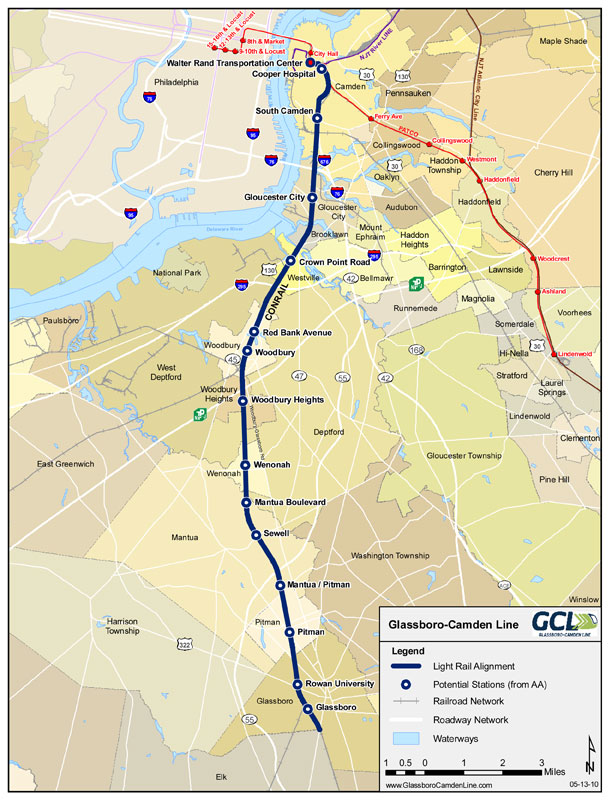New Jersey Future Blog
State Launches “Strategic State Planning Process”
March 10th, 2011 by Chris Sturm
Panelists Discuss Appropriate Circumstances for Greenfield Development
 At New Jersey Future’s Redevelopment Forum on March 4, Deputy Chief of Staff for Policy Wayne Hasenbalg outlined the Christie administration’s “State Strategic Planning Process Project.” The project will develop a framework for achieving sustainable economic growth by identifying promising growth industries and technologies and matching them to appropriate “smart growth areas.” Such a strategic direction for growth, he said, will help agencies move forward in a more coordinated fashion by aligning their rules and capital investments. The project is being directed by Hasenbalg and Environmental Protection Commissioner Bob Martin, and will engage both cabinet members and external stakeholders. The group will submit final recommendations for the Governor by June 29.
At New Jersey Future’s Redevelopment Forum on March 4, Deputy Chief of Staff for Policy Wayne Hasenbalg outlined the Christie administration’s “State Strategic Planning Process Project.” The project will develop a framework for achieving sustainable economic growth by identifying promising growth industries and technologies and matching them to appropriate “smart growth areas.” Such a strategic direction for growth, he said, will help agencies move forward in a more coordinated fashion by aligning their rules and capital investments. The project is being directed by Hasenbalg and Environmental Protection Commissioner Bob Martin, and will engage both cabinet members and external stakeholders. The group will submit final recommendations for the Governor by June 29.
As part of this effort, the administration will host a two-day workshop organized by the Governor’s Institute for Community Design, where national experts will advise New Jersey. The project builds on the administration’s work to mobilize resources by moving the Office of Smart Growth to the Department of State, renaming it the Office of Planning Advocacy and hiring Executive Director Gerry Scharfenberger and Deputy Director Dan Kennedy.
At the Redevelopment Forum, Jay Biggins, executive managing director at Biggins, Lacy & Shapiro, provided a market-based perspective on state planning by describing how corporations decide where to locate facilities. Corporate site selection criteria include quality of life, access to skilled labor, competitive costs, infrastructure (including transportation) and regulatory predictability — all of which are interrelated and interdependent, he said, and can be translated into State Plan objectives. Sustainability of the environment and creative urban places have become particularly important in attracting talented workers, he added, emphasizing that “a State Plan” informed by site selection criteria must be in place soon to create competitive and successful locations that will lead to economic growth.
Carleton Montgomery, executive director of the Pinelands Preservation Alliance, described how experience with regional planning in the Pinelands can inform the state planning discussion. By providing very clear regulations for growth, he noted, the Pinelands plan provides a predictable, efficient review process. The Pinelands Commission’s independent authority to regulate activity in the region has forced cooperation. Resistance to growth, however, combined with inadequate design standards, has led to sprawl in regional growth areas, he observed. Based on the Pinelands experience, a successful state planning effort will depend on a clear and powerful vision for growth that can guide decisions, as well as geographic lines that prescribe where development can and cannot occur in order to limit greenfield development from inappropriate locations. Montgomery described how a new manufacturing facility was built on a greenfield location inside Hammonton’s growth boundary, providing a new ratable to the city while minimizing negative impacts.
Biggins noted that while young employees in particular are shifting corporate tastes toward LEED buildings in hip, sustainable locations, many employers still prefer suburban office parks, requiring the state to have a “diverse inventory” of sites. An important next step for the State Strategic Planning Process Project will be to distinguish between “smart” greenfield locations near or adjacent to existing infrastructure and “dumb” locations that break up natural areas and require long commutes.
Ed McKenna, chair of the State Planning Commission, noted how past administrations have allowed the commission to create a plan, but have not given it the ability to implement. Biggins agreed that previous state planning efforts lacked the statutory teeth, resources and/or commitment from the “front office” needed to be relevant in mediating the ongoing push and pull among competing interests. By linking the state’s land use plan with its economic growth strategy, the Christie administration hopes not only to plan, but to get results.
Related Posts
Tags: Christie, SPC, State Planning

















we enjoyed the March 4th redevelopment forum in new brunswick
We wish the Governor’s Institute for Community Design was open for public input and ideas
I agree that the Institute for Community Design would benefit from public input, particularly from land use professionals. Far too often, statewide initiatives in redevelopment are thwarted because they conflict with the Municipal Land Use Law. Planners, land use attorneys, engineers and environmental consultants need to adopt a more integrated approach. The broad goals of redevelopment and the state plan don’t “get off the ground” because when it comes time for real world implementation in local ordinances, they are fettered by dated, common law concepts that underlie parts of the MLUL. I hope the Institute accounts for this.
Patrick, you should send your comments to the folks running the “state strategic planning process”. You can find contact info here: http://nj.gov/state/planning/sspp.html#docs.
The Governor’s Institute workshop is just a small piece of that larger process. The Governor’s Insitute for Community Design (govinstitute.org)offers its services to governors who would like to convene cabinet members and senior staff for a day and one-half long workshop. By design, members of the public and outside groups like ours are not typically included.
Chris
Thanks for the advice, Chris!
[…] keeps housing affordable, and provides more transportation choices.” For more, check out their coverage of the launch of the “Strategic State Planning Process” at the […]